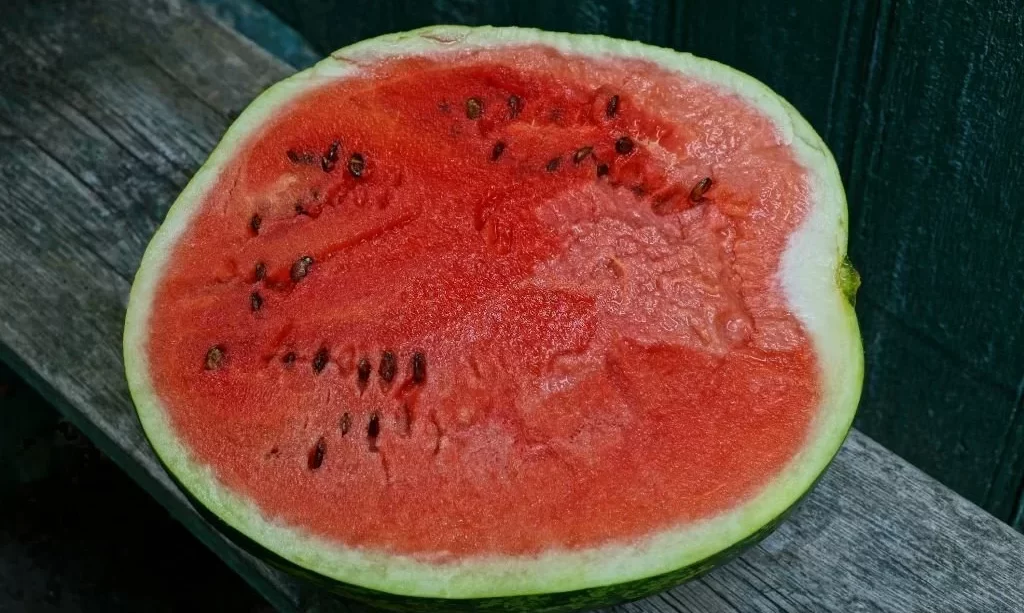Watermelons, with their vibrant green rinds and juicy, refreshing flesh, are an iconic summer treat cherished by people of all ages. When we think of this beloved fruit, we often envision its quintessential red or pink interior, bursting with sweetness. However, it’s not uncommon to encounter a watermelon with yellow spots inside, sparking curiosity and sometimes concern. In this exploration of watermelons and their ripeness, we will delve into the fascinating world of this fruit and uncover the secrets behind those yellow spots. Let’s embark on a journey to answer the question: Is it safe to eat watermelon with yellow spots inside, and what do these spots signify?
- FLORIDA GROWN
- SEEDED OR SEEDLESS
- WHOLE WATERMELONS
- FRESH FROM FLORIDA
Watermelon Ripeness
Watermelon ripeness is a critical factor in determining not only its flavor but also its overall quality. The journey from a small green fruit on the vine to a sweet, juicy watermelon involves several stages of growth and ripening. Understanding the signs of ripeness is essential for selecting the best watermelon.
One of the primary indicators of ripeness is the color of the watermelon’s skin. A fully ripe watermelon typically has a uniform, deep green color without any traces of white or pale green areas. The skin should also have a dull, matte appearance rather than a shiny one. This dullness suggests that the watermelon is ready to be harvested.
Another characteristic to consider is the sound the watermelon makes when tapped. A ripe watermelon will produce a hollow sound when gently tapped with your knuckles. This resonant thud indicates that the fruit is full of juice and ready to be enjoyed.
Perhaps the most crucial aspect of watermelon ripeness is its sweetness and juiciness. A perfectly ripe watermelon should be sweet, with a burst of juice when you take a bite. The sweetness is a result of natural sugars in the fruit, which develop as it ripens on the vine.
As we delve deeper into the nuances of watermelon ripeness, we will uncover the intriguing factors that influence its taste and texture, including the appearance of those occasional yellow spots inside.
The Occurrence of Yellow Spots
Yellow spots inside a watermelon, while less common, can sometimes be encountered when slicing open this beloved fruit. These spots can raise questions about the watermelon’s quality and edibility. Here’s what you need to know about the occurrence of yellow spots:
Yellow spots inside a watermelon are typically a result of under-ripeness or uneven ripening. During the growth process, the sugars in the fruit may not have fully developed in certain areas, leading to discoloration. This can happen due to various factors, including variations in weather conditions, sun exposure, or the position of the fruit on the vine.
When a watermelon is exposed to inconsistent sunlight during its growth, it can result in uneven ripening. Areas that receive less sunlight may remain less sweet and develop a yellowish or pale hue compared to the rest of the fruit.
It’s important to note that the presence of yellow spots does not necessarily indicate spoilage or contamination. Instead, it’s primarily an aesthetic issue that can affect the fruit’s taste and texture.
Is It Safe to Eat Watermelon with Yellow Spots?
The key question many people have when encountering a watermelon with yellow spots inside is whether it’s safe to eat. In most cases, watermelons with yellow spots are safe to consume, and the yellow areas are not harmful. However, there are a few important considerations to keep in mind:
- Lack of Optimal Flavor: Watermelon with yellow spots may not have the same level of sweetness and juiciness as fully ripe watermelons. The yellow areas are often less flavorful, which can impact the overall taste experience.
- Texture Differences: The texture of the yellow spots can also differ from the rest of the fruit. They may be less crisp and have a slightly different mouthfeel.
- Removal Option: If you encounter yellow spots while slicing a watermelon, you can choose to remove these areas and enjoy the ripe sections. This allows you to minimize any potential impact on taste and texture.
- Creative Uses: Some individuals prefer to use watermelon with yellow spots in creative ways, such as blending it into smoothies or incorporating it into fruit salads, where the difference in flavor and texture is less noticeable.
Ultimately, while watermelon with yellow spots is generally safe to eat, it may not offer the same taste and quality as fully ripe watermelons. The presence of these spots is primarily an indicator of the fruit’s ripeness and growing conditions rather than a health concern.
Taste and Texture Considerations
When it comes to watermelon with yellow spots inside, taste and texture are important factors to consider. Here’s what you need to know:
- Taste: Yellow spots inside a watermelon are typically less sweet than the surrounding red or pink flesh. The sugar content in these areas may not have fully developed, resulting in a milder, sometimes slightly bland taste. If you value the classic, juicy sweetness of watermelon, you may find the yellow spots less satisfying in comparison.
- Texture: The texture of the yellow spots can also differ. They may be softer or less crisp than the fully ripe portions of the fruit. This difference in texture can affect the overall mouthfeel of the watermelon as you bite into it.
Despite these considerations, some people still enjoy watermelon with yellow spots for its unique qualities. The milder taste and softer texture can have their own appeal, especially if you’re looking for a fruit that’s not overly sweet.
Tips for Selecting the Best Watermelon
To ensure that you select the best watermelon for your preferences and avoid those with yellow spots, consider these tips:
- Check for Uniform Color: Look for watermelons with a uniform, deep green color without pale or yellowish areas. A consistent hue is often a sign of even ripening.
- Inspect the Surface: Examine the surface of the watermelon for any blemishes or irregularities. A smooth, unblemished rind is an indicator of quality.
- Check the Sugar Spot: Some watermelons have a “sugar spot,” a creamy or yellowish area on the rind. This spot is not an indication of internal ripeness but can suggest a sweeter fruit.
- Give It a Tap: Gently tap the watermelon with your knuckles and listen for a hollow sound. A ripe watermelon will produce a resonant thud, indicating that it’s full of juice.
- Feel the Weight: A ripe watermelon should feel heavy for its size, which is a sign of juiciness. If it feels too light, it might be underripe.
- Ask for a Sample: If you’re shopping at a local market or grocery store, don’t hesitate to ask for a sample slice to taste-test the watermelon’s quality before purchasing.
Conclusion
In conclusion, the presence of yellow spots inside a watermelon is not a cause for alarm in terms of safety. Watermelons with these spots are generally safe to eat and do not indicate spoilage or contamination. However, it’s important to be aware of the taste and texture differences that yellow spots may bring.
Watermelon is at its peak when it’s fully ripe, with a sweet, juicy, and crisp interior. While some individuals may enjoy the milder taste and softer texture of yellow-spotted areas, others may prefer the classic watermelon experience. When selecting a watermelon, follow the tips provided to ensure you choose one that suits your taste preferences and provides the delightful, refreshing experience that this beloved summer fruit is known for.





